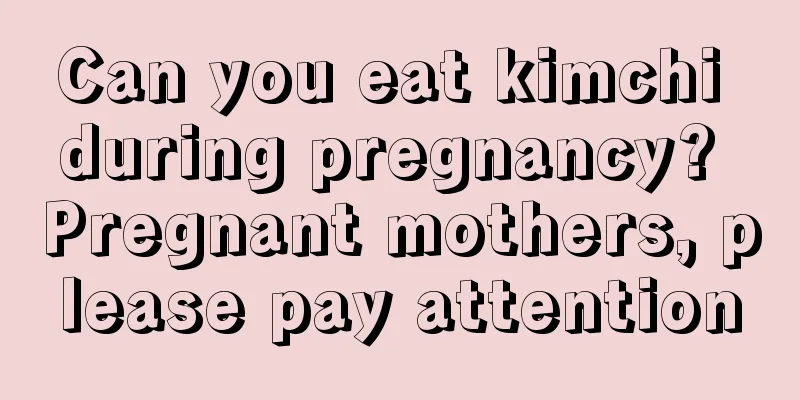Can you eat kimchi during pregnancy? Pregnant mothers, please pay attention

|
Kimchi is a must-have for every household as a food accompaniment. Pregnant mothers sometimes want to use kimchi to stimulate their appetite when they have no appetite. So can pregnant mothers eat kimchi? Will the nitrite in it affect the fetus? Let's take a look. Can I eat kimchi when I'm pregnant?You can eat it, but eat less. Kimchi is a pickled food, which contains many chemical ingredients and is not very fresh, but many pregnant women like kimchi very much, especially when they have morning sickness. To ensure health, you can choose to make some kimchi yourself, which can both satisfy your craving and be relatively clean. What are the dangers of eating kimchi during pregnancyAfter pregnancy, some women become fond of sour food, so they often eat a lot of pickles and kimchi. However, Dr. Zhong from the Department of Obstetrics and Gynecology recommends that pregnant women can occasionally eat a small amount of pickles and kimchi, but excessive intake is not good for the health and development of themselves and the fetus. There are nitroso compounds in pickles and sauerkraut. These substances are highly carcinogenic and can induce tumors in various animals and various tissues and organs. It is worth noting that some nitroso compounds can pass through the placenta to cause uterine tumors and induce fetal malformations. But it does not mean that you cannot eat sour foods. After all, sourness can stimulate the secretion of gastric juice, increase the activity of digestive enzymes, promote gastric peristalsis, and facilitate the digestion of food and the absorption of various nutrients. Therefore, eating sour foods after pregnancy is beneficial to the health of the fetus and the mother, but you must be selective when eating. Is eating kimchi often harmful to the body?Harmless, consume in moderation. The nitrite content of kimchi can reach its peak within the first 5 days of pickling. After the 8th day, the nitrite content in kimchi began to decline significantly. This may be because when the kimchi was first pickled, the environment in the jar was conducive to the reproduction of accumulated bacteria (including some nitrate-reducing bacteria), which can promote the reduction of nitrate to nitrite. However, as the pickling time increased, lactic acid bacteria also multiplied in large numbers, which had a certain inhibitory effect on nitrate-reducing bacteria, affecting their growth and reproduction, causing the nitrite content in kimchi to decrease again. On the other hand, the nitrite content in heated and unknown heated kimchi basically did not change. This shows that eating kimchi after cooking does not reduce the harm of nitrite in kimchi to the human body. The nitrite content that causes harm to the human body is 300 mg to 500 mg ingested at one time. For example, if nitrite is mistakenly consumed as salt or a large amount of unpickled pickles and kimchi is taken, it may cause poisoning. In addition, nitrite poisoning and nitrosamine carcinogenesis are not the same thing. Nitrite will not be converted into nitrosamines in the presence of vitamin C and in the body. Nitrite in food and nitrosamines should not be confused as carcinogenic. Therefore, there is no need to worry too much. Homemade kimchiPreparation ingredients 5000g Chinese cabbage, 250g apples, 250g pears, 500g white radish, 1500g beef broth, 250g green onions, 250g garlic, 150g refined salt, 150g chili powder, 50g MSG Production Process 1. Remove the roots and old stalks of the cabbage, wash it with clean water, drain it, cut it into 4 pieces with a knife, put it in a pot, sprinkle it with salt and marinate for 4 to 5 hours. 2. Remove the roots, whiskers and skin of the radish, cut into thin slices and marinate with salt 3. Peel the apples and cut into slices; chop the green onions and mash the garlic 4. Drain the pickled cabbage and radish and put them into the jar. 5. Mix all the seasonings including apples, pears, beef broth, etc. and pour them on the cabbage. The marinade should cover the cabbage. Press it down with a clean heavy object to make the cabbage sink. 6. The time can be determined according to the season. In summer, it is generally 1 to 2 days; in winter, it is generally 3 to 4 days before it can be taken out and eaten. |
<<: What are the common causes of insomnia during pregnancy?
Recommend
Does breastfeeding prevent breast cancer? Does not breastfeeding cause breast cancer?
Can breastfeeding prevent breast cancer? Today, l...
How to deal with children lying? Why do children lie?
When children are young, they always have a commo...
What should I do if my child has trichoderma? What should I eat if I have trichoderma?
Spring is the peak season for epidemic leukemia. ...
Can I eat bitter vegetables during breastfeeding? Will my breast milk become bitter if I eat bitter vegetables during breastfeeding?
Xiaoman health preservation starts with eating bi...
How to distinguish the authenticity of super laundry detergent? The advantages of super laundry detergent
Soon after Super Power Laundry Detergent was laun...
What should I do if my baby walks on tiptoes? How to tell if it is normal?
Some babies like to walk on tiptoes, which makes ...
What are the smart toys? How is the smart toy market?
Smart toys seem to be more attractive to children...
Can babies get vaccinations while taking medicine? Will babies taking medicine affect vaccinations?
Vaccination for babies is very important. Today, ...
What are the symptoms of baby getting angry? See how to care for it with Chinese and Western medicine
Maybe one day you suddenly find out why your baby...
Where can I apply for a child health handbook? How can I get a replacement if I lose it?
The Child Health Handbook records the physical he...
What is the best way to drown the neck? Moms should pay attention.
Many new parents fail to wipe off the water in ti...
Is it okay for my baby not to go to kindergarten? Is it okay for my baby not to go to kindergarten?
Is it okay for babies not to go to kindergarten? ...
What are the items in a premarital physical examination? What does a premarital physical examination check?
Getting married soon is a very happy thing, but n...
Can pregnant women eat chicken feather vegetables? It is rich in vitamins
Pregnant women can eat some chicken feather veget...
Is it a big deal if the baby's umbilical cord falls off? What should I do if the baby's umbilical cord falls off and bleeds?
The umbilical cord care of newborns is very impor...









